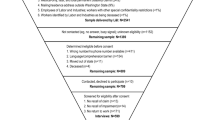Abstract
The labor market impact of upper extremity musculoskeletal injuries that result in permanent disability was estimated using data from the State of California. Administrative data on disability evaluations and resulting ratings was matched to data on the earnings of over 7000 injured workers. Using these data, labor market experience pre- and postinjury was tracked. Each injured worker was matched to a set of control workers who worked at the same firm, had the same tenure at the firm, and earned the same income at the time of injury. By comparing the injured and uninjured workers, lost earnings and the impact of injury on return to work was estimated. Evidence of considerable lost earnings resulting from injury was found. The results are compared to “disability ratings” that are used to set compensation under California's workers' compensation program. The disability rating was also found to predict poorly differences across upper extremity injuries in losses. In particular, those with shoulder injuries have larger losses than those with elbow or wrist injuries, despite receiving the same disability ratings.
Similar content being viewed by others
REFERENCES
Workers' Compensation Insurance Rating Bureau of California. 1996 California Workers' Compensation Losses and Expenses. San Francisco: Workers' Compensation Insurance Rating Bureau of California, 1997.
Silverstein B, Welp E, Nelson N, Kalat J. Claims incidence of work-related disorders of the upper extremities: Washington State, 1987 through 1995. Am J Public Health 1998; 88: 1827-1833.
Peterson M, Reville R, Kaganoff-Stern R. Compensating Permanent Workplace Injuries: A Study of the California System. Santa Monica, CA: RAND, 1996, MR-920-ICJ.
Biddle J. Estimation and analysis of long term wage losses and wage replacement rates of Washington state workers' compensation claimants. Olympia, WA: Department of Labor and Industry, 1998.
Butler RJ, Johnson WG, Baldwin ML. Managing work disability: Why first return to work is not a measure of success. Indus Labor Relat Rev 1995; 48: 452-469.
Boden L, Galizzi M. Economic consequences of workplace injuries: Lost earnings and benefit adequacy. Am J Ind Med 1999; 36: 487-503.
Reville R, Schoeni R. Disability from injuries at work: The effects on earnings and employment. Santa Monica, CA: RAND, 2001, DRU-2554.
Division of Workers' Compensation. Schedule for rating permanent disabilities. Sacramento: California Department of Industrial Relations, Division of Workers' Compensation, 1997.
American Medical Association. Guides to the evaluation of permanent impairment, 4th edn. Chicago, IL: American Medical Association, 2001.
Dehejia R, Wahba S. Causal effects in non-experimental studies: Re-evaluating the evaluation of training programs. Cambridge, MA: Working paper, Harvard University, 1996.
Heckman J, Hotz V. Choosing among alternative non-experimental methods for estimating the impact of social programs: The case of manpower training. J Am Stat Assoc 1989; 84: 862-874.
Holland P. Statistics and causal inference. J Am Stat Assoc 1986; 81: 945-960.
Lalonde R. Evaluating the econometric evaluations of training programs. Am Econ Rev 1986; 76: 604-620.
Hine C, Lewko J, Blanco J. Alignment of workplace safety principles: An application to mining. J Safety Res 1999; 30: 173-185.
Hopkins A. For whom does safety pay? The case of major accidents. Safety Sci 1999; 32: 143-153.
Stein A, Karel T, Znidema R. Carrots and sticks: Impact of an incentive disincentive employee flexible credit benefit plan on health status and medical costs. Am J Health Prom 1999; 13: 260-267.
Mital A, Pennahtur A. Musculoskeletal overexertion injuries in the U.S.: Mitigating the problem through ergonomics and engineering interventions. J Occup Rehabil 1999; 9: 115-149.
Author information
Authors and Affiliations
Corresponding author
Rights and permissions
About this article
Cite this article
Reville, R.T., Neuhauser, F.W., Bhattacharya, J. et al. Comparing Severity of Impairment for Different Permanent Upper Extremity Musculoskeletal Injuries. J Occup Rehabil 12, 205–221 (2002). https://doi.org/10.1023/A:1016898729338
Issue Date:
DOI: https://doi.org/10.1023/A:1016898729338




